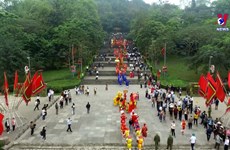Border trade gains unevenly spread
Cross-border trade benefits have not benefited all localities equally,
Hoang Minh Tuan, director of the Border and Mountainous Trade
Department, tells the Cong Thuong (Industry and Trade) newspaper.
Cross-border trade benefits have not benefited all localities equally,
Hoang Minh Tuan, director of the Border and Mountainous Trade
Department, tells the Cong Thuong (Industry and Trade) newspaper.
* What are the highlights of cross-border trade between Vietnam, Laos and Cambodia in recent years?
There have been quite a few remarkable achievements, made possible by sound legal systems adopted by local and central governments which have made it easier and more secure for enterprises, households, traders and border residents to engage in border trade.
In the past few years, a dozen international border gates have been upgraded to become economic and trade hubs.
* What are limitations that have surfaced in promoting cross border trade?
It is evident that the potential of each border locality has not been exploited. The legal framework governing cross border trade that are set up by the central and provincial governments is still incomplete despite several improvements. This has hindered investment from both domestic and foreign sources.
Though cross border trade turnover has increased steadily of late, the growth is not evenly distributed. Cross border trade in the Tay Nguyen (Central Highlands) provinces of Kon Tum and Dak Lak is still underdeveloped.
That is not all. We still lack measures to speed up border checks for people, goods and vehicles. A case in point is the inefficient operation of the East-West Corridor.
The border gates in Laos will only allow trucks to cross, not buses carrying passengers from Vietnam or other Southeast Asian nations.
Though officials of all three countries have agreed to apply a one-stop check at two international border gates: Lao Bao (in Vietnam's central Quang Tri province) and Densavan (Savanakhet province of Laos; and Moc Bai in Vietnam's Tay Ninh province) and Ba Vet (Svey Rieng province of Cambodia), this is far from becoming reality. Some sources said different quarantine procedures have proven to be a stumbling block.
The sources said another hindrance was restrictions placed by both Laos and Cambodia on Vietnamese nationals wanting to cross the border on motorbikes or even trucks.
* The border markets between Vietnam and Cambodia have not developed as expected, experts say. What is the Ministry of Industry and Trade doing about it?
As of now, there are 10 international border gates along the Vietnam-Cambodia border, nine main border gates, 30 sub-border gates, nine border economic zones, plus a network of 107 border markets.
However, these are all small scale developments and many of them are temporary. There are geographical and socio-economic factors behind this.
In the Tay Nguyen (Central Highlands) province of Dak Lak, which shares a border with Rattanakiri province in Cambodia, there are just two small convenience stores run by local households.
The governments of both countries assigned their respective trade ministries to discuss the establishment of a well developed Vietnam-Cambodia border trade network by 2020. On October 15, 2012, the plan was approved by the Vietnamese Minister of Industry and Trade.
The first Vietnam-Cambodian border market was built at the Thary special economic zone in Da Kandorl village, Da commune, Memot district, Kampong Cham province, Cambodia on January 8, 2013. Hopefully, our trade will strongly develop through this market.-VNA
* What are the highlights of cross-border trade between Vietnam, Laos and Cambodia in recent years?
There have been quite a few remarkable achievements, made possible by sound legal systems adopted by local and central governments which have made it easier and more secure for enterprises, households, traders and border residents to engage in border trade.
In the past few years, a dozen international border gates have been upgraded to become economic and trade hubs.
* What are limitations that have surfaced in promoting cross border trade?
It is evident that the potential of each border locality has not been exploited. The legal framework governing cross border trade that are set up by the central and provincial governments is still incomplete despite several improvements. This has hindered investment from both domestic and foreign sources.
Though cross border trade turnover has increased steadily of late, the growth is not evenly distributed. Cross border trade in the Tay Nguyen (Central Highlands) provinces of Kon Tum and Dak Lak is still underdeveloped.
That is not all. We still lack measures to speed up border checks for people, goods and vehicles. A case in point is the inefficient operation of the East-West Corridor.
The border gates in Laos will only allow trucks to cross, not buses carrying passengers from Vietnam or other Southeast Asian nations.
Though officials of all three countries have agreed to apply a one-stop check at two international border gates: Lao Bao (in Vietnam's central Quang Tri province) and Densavan (Savanakhet province of Laos; and Moc Bai in Vietnam's Tay Ninh province) and Ba Vet (Svey Rieng province of Cambodia), this is far from becoming reality. Some sources said different quarantine procedures have proven to be a stumbling block.
The sources said another hindrance was restrictions placed by both Laos and Cambodia on Vietnamese nationals wanting to cross the border on motorbikes or even trucks.
* The border markets between Vietnam and Cambodia have not developed as expected, experts say. What is the Ministry of Industry and Trade doing about it?
As of now, there are 10 international border gates along the Vietnam-Cambodia border, nine main border gates, 30 sub-border gates, nine border economic zones, plus a network of 107 border markets.
However, these are all small scale developments and many of them are temporary. There are geographical and socio-economic factors behind this.
In the Tay Nguyen (Central Highlands) province of Dak Lak, which shares a border with Rattanakiri province in Cambodia, there are just two small convenience stores run by local households.
The governments of both countries assigned their respective trade ministries to discuss the establishment of a well developed Vietnam-Cambodia border trade network by 2020. On October 15, 2012, the plan was approved by the Vietnamese Minister of Industry and Trade.
The first Vietnam-Cambodian border market was built at the Thary special economic zone in Da Kandorl village, Da commune, Memot district, Kampong Cham province, Cambodia on January 8, 2013. Hopefully, our trade will strongly develop through this market.-VNA













